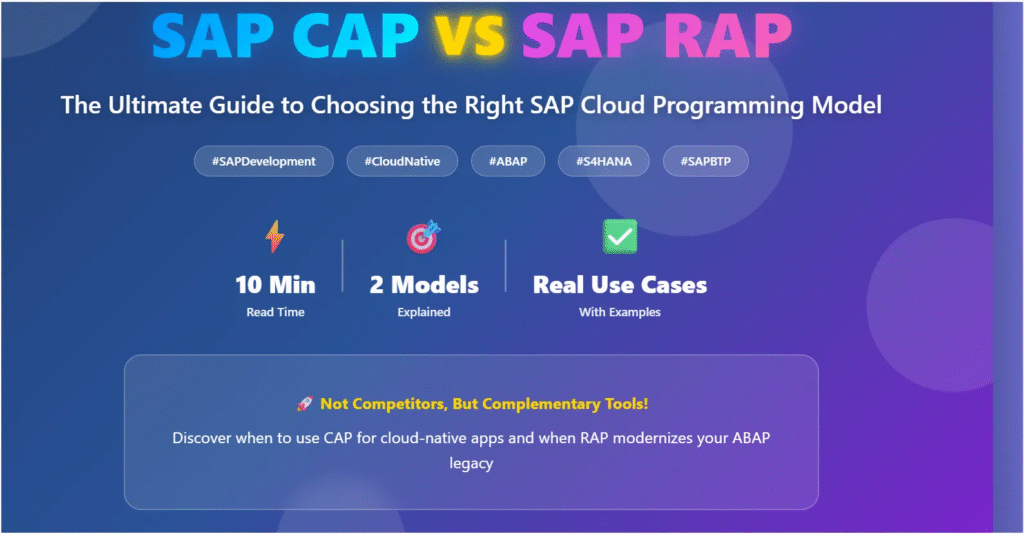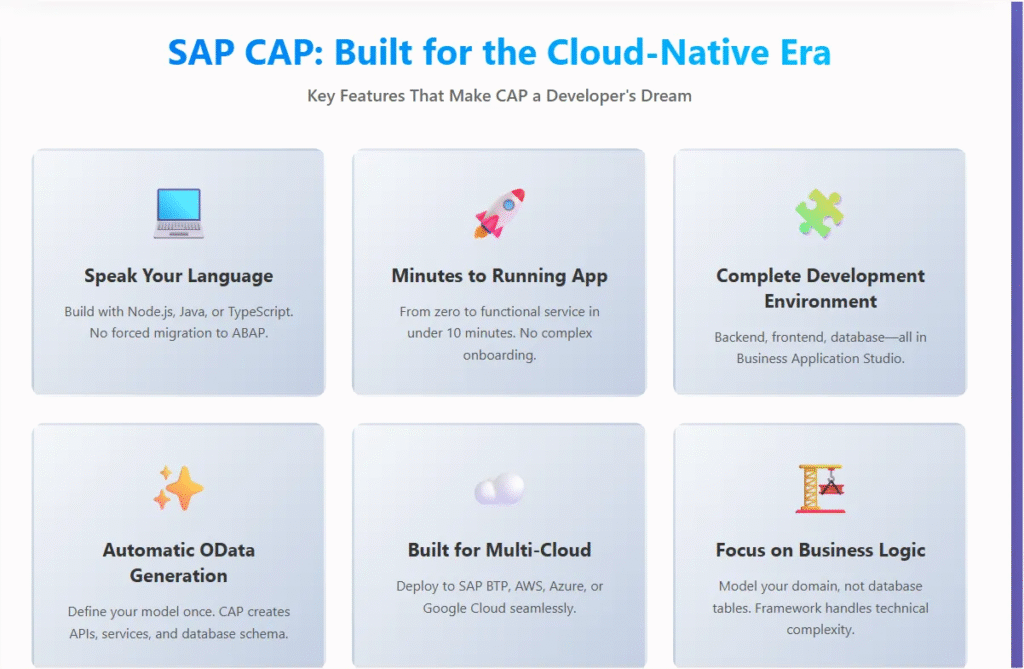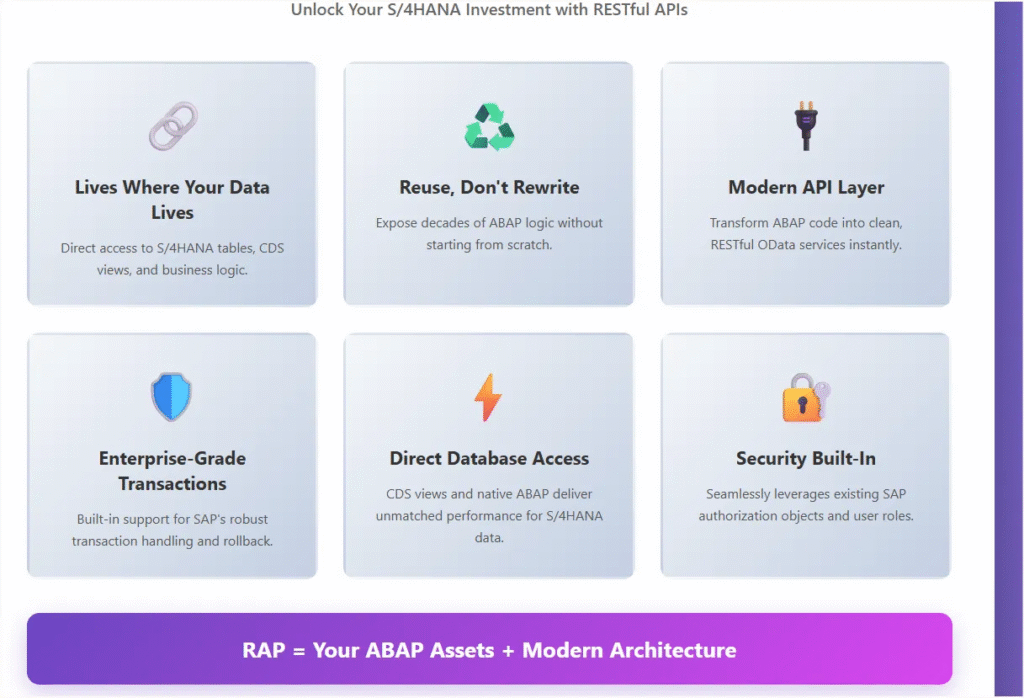SAP CAP vs SAP RAP: Wait, So CAP and RAP Aren’t Competing?
The Conversation Every SAP Developer Needs to Have

Let’s be honest, if you’ve been in the SAP world for a while, you’ve probably heard the ongoing debate:
“Should we go with CAP or RAP?”
And if you’ve ever been stuck between two consultants passionately arguing opposite sides, you know exactly how confusing it can get.
The Legacy System Challenge
Let’s Assume Your company has 15 years’ worth of battle tested ABAP code running critical business processes. Everything works fine, but now leadership wants a modern mobile app that can access all that data.
One consultant says,
“Rebuild everything with CAP — it’s cloud-native!”
Another insists,
“Use RAP — it leverages your existing investment!”
And there you are, caught in the middle, knowing that the wrong decision could cost months of effort and a blown budget.
Sound familiar?
You’re not alone.
Here’s the thing that might blow your mind:
👉 This entire debate is based on a false premise.
CAP and RAP aren’t rivals. They’re not even in the same race.
It’s like arguing whether a hammer or a screwdriver is better — the answer depends entirely on what you’re trying to build.
So grab your coffee, take a deep breath, and let’s have a real, no-marketing-jargon chat about what these frameworks actually are, when to use them, and why understanding their difference might just be the most valuable 10 minutes you spend this week.
When I First Heard About CAP…
I’ll be honest — when I first heard about CAP, my reaction was:
“Great, another framework SAP wants us to learn. What’s wrong with good old ABAP?”
But that changed the day I had to build a customer-facing portal that needed to:
- Pull data from S/4HANA
- Integrate with a third-party logistics system
- Scale for thousands of users during peak hours
Trying to do all that in traditional ABAP?
It felt like trying to cut a steak with a spoon. Technically possible? Maybe. The right tool for the job? Absolutely not.
That’s when it clicked.
SAP isn’t asking us to choose between CAP and RAP.
They’re giving us different tools for different problems.
So What Exactly Is CAP?
Let’s cut through the marketing fluff.
The Cloud Application Programming Model (CAP) is SAP’s way of saying:
“Hey, Java and JavaScript developers — we see you, and we want you to build enterprise apps too.”
Here’s what makes CAP special:

1. It Speaks Your Language
CAP doesn’t force you into ABAP.
Love Node.js? Perfect.
Prefer Java? Go ahead.
That’s a big deal — because now, you don’t need to be an ABAP guru to build SAP-grade apps. Teams can bring in developers from broader ecosystems and still maintain enterprise reliability.
2. It Handles the Boring Stuff
CAP automates the repetitive work — CRUD operations, authentication, OData exposure, database connections.
You define your data model, and CAP does the rest.
Starting a project is fast.
A few CLI commands, a CDS model that reads almost like plain English, and — boom — you’ve got a running service with APIs, a database, and more.
No week-long setups. No “works on my machine” issues. Just productivity.
It’s fast, flexible, and fun.
Now Let’s Talk About RAP

This is where things get interesting.
The RESTful ABAP Programming Model (RAP) is SAP’s way of saying to every ABAP developer:
“You don’t have to throw away 20 years of brilliant business logic to go modern.”
RAP isn’t about rebuilding everything in the cloud.
It’s about exposing your existing ABAP logic as modern RESTful APIs — safely, quickly, and cleanly.
Why RAP Is Brilliant
Let’s say your company has a sophisticated pricing engine in S/4HANA — full of ABAP logic, refined over decades.
Now you need to expose that logic for a mobile app.
You have two options:
Option A: Rewrite everything in JavaScript or Java — spend months translating logic, risk introducing bugs, and maintain two codebases.
Option B: Use RAP to wrap your existing ABAP logic in a RESTful API — in a matter of hours.
Which one makes more sense?
That’s RAP’s magic. It’s not competing with CAP — it’s solving a different problem.
RAP is your bridge between legacy reliability and modern flexibility.
The Real Question: CAP or RAP for What?

Let’s look at two real-world scenarios.
Scenario 1: When CAP Is Your Best Friend
Your company wants to build a customer self-service portal. Customers should:
- Check order status (from S/4HANA)
- Track shipments (from a logistics provider)
- Download invoices (from DMS)
- Submit tickets (via ServiceNow)
And it all needs to handle thousands of users.
Trying to build that with ABAP or RAP?
Painful.
With CAP?
Easy:
- Orchestrate data from multiple systems
- Use SAPUI5 or React for the UI
- Deploy on SAP BTP (let it handle scaling)
- Integrate external APIs
- Implement OAuth authentication
CAP is cloud-native by design. It thrives in integration-heavy, scalable, multi-system environments.
Could RAP technically do it? Sure — but it’d be like using Excel to run your entire ERP. Possible? Yes. Practical? Not really.
Scenario 2: When RAP Is Your Hero
Now flip it.
You’ve got a material valuation process in S/4HANA that’s been refined for decades. It handles every complex calculation imaginable.
And now your analytics dashboard needs that data in real time.
You could rewrite all that logic in CAP — but why reinvent the wheel?
With RAP, you can expose that same logic as an OData service in a single afternoon.
The ABAP code stays optimized and close to the data, and RAP simply gives it a modern face.
That’s smart development.
So What Makes CAP Truly Special?
Beyond being “cloud-native,” CAP stands out because:
- It embraces multiple languages, allowing diverse teams to collaborate.
- It integrates everything in Business Application Studio (BAS) — one place for backend, frontend, and database work.
- It’s future-proof — framework upgrades rarely break your code.
- It’s integration-ready — APIs, events, queues, and services are first-class citizens.
- It’s domain-driven — your business entities (Customers, Orders, Products) stay central, not hidden in technical jargon.
Before You Dive In
You’ll want to know a few basics first:
- CDS views and OData concepts
- A bit of UI5 or Fiori
- Some Node.js or Java knowledge
- Command-line comfort
- Access to SAP BTP and BAS (preloaded with all CAP tools)
Good news? You can start locally with the CAP SDK — no cloud connection needed. Build on your laptop, deploy later.
Here’s What I Wish I’d Known Earlier
The future of SAP development isn’t CAP or RAP — it’s both.
Your landscape might look like this:
- RAP exposes S/4HANA logic via APIs
- CAP consumes those APIs to build cloud apps
- Both talk through standard OData
- External systems integrate seamlessly
Smart teams don’t pick sides — they pick the right tool for the right task.
- Building a greenfield cloud app with multiple integrations? → CAP
- Modernizing existing S/4 functionality? → RAP
- Complex hybrid scenario? → Use both.
Why CAP Is the Future (and RAP Isn’t Going Anywhere)
Let’s be real — for new applications, CAP is where the world is heading:
- Multi-cloud support (BTP, AWS, Azure, GCP)
- Microservice-friendly architecture
- Modern developer experience (CLI, VS Code, BAS)
- Open-source flexibility
But that doesn’t make ABAP or RAP obsolete.
RAP remains your go-to for core business processes that demand precision, performance, and consistency.
The real power lies in using both — strategically.
The Bottom Line
Stop thinking of CAP and RAP as enemies. They’re not fighting each other — they’re complementing each other.
- CAP → for cloud-native, scalable, integration-heavy, greenfield projects.
- RAP → for exposing existing ABAP logic and modernizing your SAP core.
Sometimes you’ll use one.
Sometimes both.
That’s not confusion — that’s mastery.
The competitive edge doesn’t come from picking a side.
It comes from knowing which framework solves which problem, and using each effectively.
Coming Up Next
In the next blog, we’ll get hands-on — setting up your BTP account for CAP development the right way:
- Account structure
- Entitlements
- User management
- Business Application Studio setup
No trial-and-error, no guessing — just a clear, working setup.
Then, we’ll build your first CAP project, debug together, and dive into real-world integrations — including connecting CAP with RAP services.
Because talking about frameworks is fun —
but building real applications that solve real problems?
That’s where the magic happens.
Got thoughts on CAP vs RAP?
Drop them in the comments — I genuinely love discussing this stuff. Let’s figure it out together.
